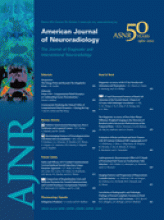Research ArticleBrain
Open Access
CT Perfusion Mean Transit Time Maps Optimally Distinguish Benign Oligemia from True “At-Risk” Ischemic Penumbra, but Thresholds Vary by Postprocessing Technique
Shervin Kamalian, Shahmir Kamalian, A.A. Konstas, M.B. Maas, S. Payabvash, S.R. Pomerantz, P.W. Schaefer, K.L. Furie, R.G. González and M.H. Lev
American Journal of Neuroradiology March 2012, 33 (3) 545-549; DOI: https://doi.org/10.3174/ajnr.A2809
Shervin Kamalian
Shahmir Kamalian
A.A. Konstas
M.B. Maas
S. Payabvash
S.R. Pomerantz
P.W. Schaefer
K.L. Furie
R.G. González

References
- 1.↵
- Wintermark M,
- Flanders AE,
- Velthuis B,
- et al
- 2.↵
- Wintermark M,
- Albers GW,
- Alexandrov AV,
- et al
- 3.↵
- Baird AE,
- Benfield A,
- Schlaug G,
- et al
- 4.↵
- Nagakane Y,
- Christensen S,
- Brekenfeld C,
- et al
- 5.↵
- 6.↵
- Obach V,
- Oleaga L,
- Urra X,
- et al
- 7.↵
- 8.↵
- Schellinger PD,
- Bryan RN,
- Caplan LR,
- et al
- 9.↵
- Kucinski T,
- Naumann D,
- Knab R,
- et al
- 10.↵
- Kane I,
- Carpenter T,
- Chappell F,
- et al
- 11.↵
- Takasawa M,
- Jones PS,
- Guadagno JV,
- et al
- 12.↵
- Konstas AA,
- Lev MH
- 13.↵
- Schaefer PW,
- Mui K,
- Kamalian S,
- et al
- 14.↵
- Kudo K,
- Sasaki M,
- Yamada K,
- et al
- 15.↵
- 16.↵
- Wu O,
- Ostergaard L,
- Weisskoff RM,
- et al
- 17.↵
- Murphy BD,
- Fox AJ,
- Lee DH,
- et al
- 18.↵
- Murphy BD,
- Fox AJ,
- Lee DH,
- et al
- 19.↵
- W SS
- Smith SW
- 20.↵
- Wintermark M,
- Reichhart M,
- Thiran JP,
- et al
- 21.↵
- Rordorf G,
- Koroshetz WJ,
- Copen WA,
- et al
- 22.↵
- Cenic A,
- Nabavi DG,
- Craen RA,
- et al
- 23.↵
- Kamalian S,
- Kamalian S,
- Maas MB,
- et al
- 24.↵
- Christensen S,
- Mouridsen K,
- Wu O,
- et al
In this issue
Advertisement
Shervin Kamalian, Shahmir Kamalian, A.A. Konstas, M.B. Maas, S. Payabvash, S.R. Pomerantz, P.W. Schaefer, K.L. Furie, R.G. González, M.H. Lev
CT Perfusion Mean Transit Time Maps Optimally Distinguish Benign Oligemia from True “At-Risk” Ischemic Penumbra, but Thresholds Vary by Postprocessing Technique
American Journal of Neuroradiology Mar 2012, 33 (3) 545-549; DOI: 10.3174/ajnr.A2809
0 Responses
CT Perfusion Mean Transit Time Maps Optimally Distinguish Benign Oligemia from True “At-Risk” Ischemic Penumbra, but Thresholds Vary by Postprocessing Technique
Shervin Kamalian, Shahmir Kamalian, A.A. Konstas, M.B. Maas, S. Payabvash, S.R. Pomerantz, P.W. Schaefer, K.L. Furie, R.G. González, M.H. Lev
American Journal of Neuroradiology Mar 2012, 33 (3) 545-549; DOI: 10.3174/ajnr.A2809
Jump to section
Related Articles
- No related articles found.
Cited By...
- Excellence is a habit: Enhancing predictions of language impairment by identifying stable features in clinical perfusion scans
- Detecting CTP Truncation Artifacts in Acute Stroke Imaging from the Arterial Input and the Vascular Output Functions
- Endovascular thrombectomy beyond 12 hours of stroke onset: a stroke networks experience of late intervention
- Perfusion Computed Tomography for the Evaluation of Acute Ischemic Stroke: Strengths and Pitfalls
- C-Arm Flat Detector CT Parenchymal Blood Volume Thresholds for Identification of Infarcted Parenchyma in the Neurointerventional Suite
- Limited Reliability of Computed Tomographic Perfusion Acute Infarct Volume Measurements Compared With Diffusion-Weighted Imaging in Anterior Circulation Stroke
- Optimal Perfusion Computed Tomographic Thresholds for Ischemic Core and Penumbra Are Not Time Dependent in the Clinically Relevant Time Window
- Pretreatment Advanced Imaging in Patients with Stroke Treated with IV Thrombolysis: Evaluation of a Multihospital Data Base
- Toward Patient-Tailored Perfusion Thresholds for Prediction of Stroke Outcome
- CT Brain Perfusion Protocol to Eliminate the Need for Selecting a Venous Output Function
- Imaging-based selection for intra-arterial stroke therapies
- Location of the Clot and Outcome of Perfusion Defects in Acute Anterior Circulation Stroke Treated with Intravenous Thrombolysis
- Comments on an Article by Kamalian et al
- Reply:
- Acute Stroke Imaging: CT with CT Angiography and CT Perfusion before Management Decisions
This article has not yet been cited by articles in journals that are participating in Crossref Cited-by Linking.
More in this TOC Section
Similar Articles
Advertisement











